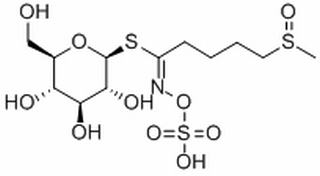Home
Products
Glucoraphanin



| Product Name | Glucoraphanin |
| Price: | $176 / 10mg |
| Catalog No.: | CN01029 |
| CAS No.: | 21414-41-5 |
| Molecular Formula: | C12H23NO10S3 |
| Molecular Weight: | 437.5 g/mol |
| Purity: | >=98% |
| Type of Compound: | Alkaloids |
| Physical Desc.: | Powder |
| Source: | The seeds of Raphanus sativus L. |
| Solvent: | DMSO, Pyridine, Methanol, Ethanol, etc. |
| SMILES: | OC[C@H]1O[C@@H](S/C(=NOS(=O)(=O)O)/CCCCS(=O)C)[C@@H]([C@H]([C@@H]1O)O)O |
| Contact us | |
|---|---|
| First Name: | |
| Last Name: | |
| E-mail: | |
| Question: | |
| Description | Glucoraphanin, a natural glucosinolate found in cruciferous vegetable, is a stable precursor of the Nrf2 inducer sulforaphane, which possesses antioxidant, anti-inflammatory, and anti-carcinogenic effects. |
| In Vivo | Glucoraphanin reduces weight gain and increases energy expenditure in HFD-fed mice. Glucoraphanin can improves insulin sensitivity and glucose tolerance in HFD-fed mice. However, Glucoraphanin does not exert antiobesity and insulin-sensitizing effects in Nrf2−/− Mice. Glucoraphanin blocks HFD-induced reduction of Ucp1 protein levels in white adipose depots of wild-type mice but not in Nrf2−/− mice. Glucoraphanin alleviates HFD-induced hepatic steatosis and oxidative stress. Glucoraphanin suppresses HFD-induced proinflammatory activation of macrophages in liver and adipose tissue. Glucoraphanin also decreases circulating LPS and the relative abundance of proteobacteria in the gut microbiomes of HFD-fed mice[1]. Mice with pellets including 0.1% Glucoraphanin (GF) significantly attenuates the decreased social avoidance time in stressed mice. In the 1% sucrose preference test (SPT), treatment with pellets including 0.1% GF significantly attenuates the decreased sucrose preference of stressed mice[2]. |
| Animal Admin | Male C57BL/6JSlc mice are 7 weeks of age. The Nrf2 knockout (Nrf2−/−) mouse strain is used in the assay. After 1 week of acclimation, mice are fed normal chow (NC) (containing 2.2% dextrinized cornstarch, 10% kcal from fat), NC containing 0.3% glucoraphanin (NC-GR) (containing 2.2% extract powder), an HFD (containing 2.2% dextrinized cornstarch, 60% kcal from fat), or an HFD containing 0.3% glucoraphanin (HFD-GR) (containing 2.2% extract powder) for 14 weeks. Both the NC and the HFD containing cornstarch or glucoraphanin are prepared. All mice studied are maintained on a 12-h light/dark cycle at 24-26°C with free access to water and food. |
| Exact Mass | 436.041138 |
| PSA | 236.07000 |
| LogP | -0.53 |
| Storage condition | 2-8℃ |